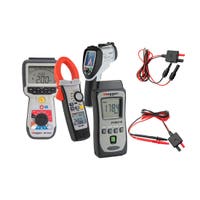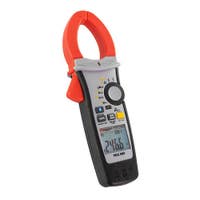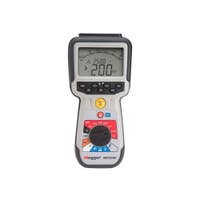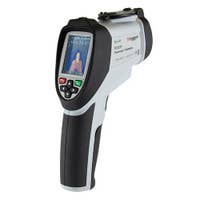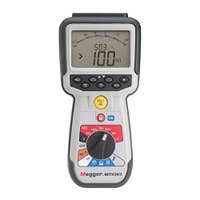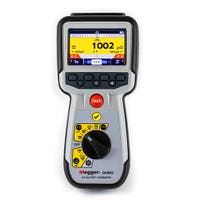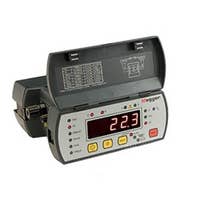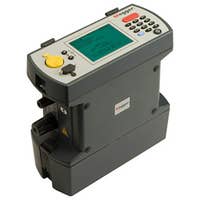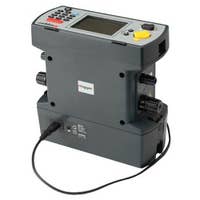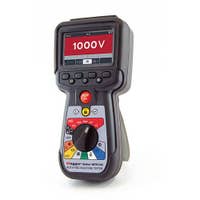This site uses cookies to provide an optimized shopping experience. By using this site, you agree the use of cookies within our privacy policy.


Megger: Alternative and Renewable Energy Solutions
Megger Solar Energy Solutions
The importance of solar energy continues to increase significantly as the cleanest and most abundant renewable energy source on the planet. In the past decade, the solar power market in the United States has practically doubled every year, for both residential and utility services, with over 2.6 million solar installations across the United States. Having the right equipment to install, maintain and test solar systems is critical for keeping energy production efficient and consistent.
Photovoltaic (PV) systems are a rapidly growing segment of the electrical industry. Arrays are being installed around the world to help derive clean, pure energy from the sun and combat greenhouse gas emissions, while reducing our collective dependence on fossil fuel. To meet the increasing needs of the technicians who install this equipment, proper tools, like those found in Megger's Solar Test Kit, are essential in testing and maintaining these systems.
Megger is committed to providing high quality affordable tools that allow industry technicians to maintain solar equipment safely and effectively.
PV Applications:
- Performance Verification
- PV System Maintenance
- Ground Fault Testing in PV Systems
- Visual Inspection
- Continuity Testing
- Polarity Testing
- Voltage and Currency Testing
Solar Testing Kit
Technicians need accurate and easy-to-use tools when working on PV systems. Megger's solar test kit provides these technicians with the tools and resources needed to safely and effectively install, commission and maintain PV arrays of all sizes, and provide system owners and operators the information required to maintain their investments.
Buy Megger Solar Testing Kits Now!
DCM1500S Digital Clamp Meter
The Megger DCM1500S digital clamp meter meets the needs of PV technicians working in any market segment. Standard meter features include:
- 2,000 VDC and 1,000 VAC measurement capabilities
- Standard probes, alligator clamps and PV-specific MC4 leads
- 1,500 A AC and DC current measurements
- Temperature probe
- Bluetooth communication and recording
- Non-contact voltage detection
Buy Megger Digital Clamp Meters Now!
PVM210 Irradiance Sensor
The PVM210 is a handheld sensor from Megger that allows users to quickly measure the irradiance or intensity of the sunlight striking the array. Since the amount of current a PV module can produce is directly proportional to the irradiance striking the array, this measurement is critical when validating the performance of a PV system. The PVM210 provides technicians the ability to correlate the current output from their array with the irradiance for accurate calculations on the array performance. Features include:
- Multiple units of measurement, BTU and W/m2
- Hold button to freeze reading on display
- Range feature to provide more accurate readings in low light conditions
- Zero button to calibrate tool
Buy Megger Irradiance Sensors Now!
MIT2500 Insulation Resistance Tester
The Megger MIT2500 is a handheld insulation resistance tester with the ability to run tests from 50 V to 2,500 V with readings up to 200 GΩ. This provides field technicians the ability to perform IR tests on all PV and inverter output circuits for residential, commercial and utility-scale systems. It also can be used per ANSI guidelines on circuits with ratings less than 25 kV, making it applicable on many large-scale installations. The integrated guard terminal provides a higher level of accuracy by properly accounting for surface leakage during IR tests. This gives the user a higher degree of confidence in their results and a better set of data for analyzing the conductors. Features include:
- Only handheld IR tester with integrated guard terminal
- Internal data storage with Bluetooth connectivity for data transmission
- Rechargeable battery options
- Voltage, resistance and capacitance testing capabilities
- Adjustable pass/fail levels for quick field evaluation
Buy Megger Insulation Resistance Testers Now!
TC3231 Thermal Camera
Megger's TC3231 is a thermal camera that allows users to quickly and safely assess the PV modules, junction boxes, combiner boxes and electrical connections for abnormal heat. The camera can be used to scan PV modules that have been identified for poor performance to locate bad cells, wiring or diodes. The camera can also be used to analyze electrical connections in inverters, combiner boxes and panelboards to identify poor connections and possible failure points. Features include:
- SIM card for storing up to 6,000 images
- -4° to 572° F (-20° C - 300° C) temperature range
- Image blending to allow non thermal images and multiple levels of thermal visibility
- Adjustable emissivity gain for various surfaces being tested
- Time display to assist in data collection and analysis
Buy Megger Thermal Cameras Now!
Photovoltaic Kits
Paired with a multimeter or clamp meter, Megger's photovoltaic kits are perfect for installing, commissioning, and testing solar installations – enabling electricians or engineers to verify the stated short circuit current.
The PVK320 kit offers the solar/photovoltaic engineer the multimeter option of verifying, with the PVM210 irradiance meter, the stated short circuit current as provided by the manufacturer of the solar panel as required by published standards.
The PVK330 kit offers the solar/photovoltaic engineer a clamp meter option of verifying, with the PVM210 irradiance meter, the stated short circuit current as provided by the manufacturer of the solar panel as required by published standards. In addition, this clamp meter offers the option of testing the current within each 'string' on a larger solar array without disconnection of cables.
Note: When installing, commissioning and testing a photovoltaic installation, additional instrumentation is required to accompany the usual electrician's test equipment (such as the Megger MFT1730 and MFT1835 multifunction testers).
What's in the Box?


PVM210 Kit
PVM210 Irradiance Meter
AVO410 CATIV TRMS Multimeter
MC4 Solar Connectors to 3/16 in. Standard Plug Test Leads
MC3 to MC4 Adapter Test Leads
PV Kit Storage Pouch


PVK330 Kit
PVM210 Irradiance Meter
DCM340 600 A AC / DC Clampmeter
MC4 Solar Connectors to 3/16 in. Standard Plug Test Leads
MC3 to MC4 Adapter Test Leads
PV Kit Storage Pouch
Buy Megger Photovoltaic Kits Now!
MPQ1000 Handheld Power Quality Analyzer
The MPQ1000 power quality analyzer from Megger is an advanced handheld 3-phase analyzer. It is a highly intuitive analyzer that delivers unmatched capability in a smart ergonomic platform. View RMS data, waveforms, demand data, phase angles, harmonics, unbalance, flicker and more in real time with the MPQ1000 scope mode and DVM mode. When data needs to be recorded the MPQ1000 record verification will automatically identify the current clamps, recognize their range and verify the unit is connected properly. Simply connect it and push the record button. The MPQ1000 can record for extended periods of time because of its massive memory. It utilizes an SD card, which makes expanding the memory as easy as installing a new SD card. The recorded data can be viewed on the MPQ1000 color VGA display or the data can be transferred to the high power Megger PQ Power Quality Analysis software via USB cable, USB stick, Ethernet or directly from the SD card.
Buy Megger Handheld Power Quality Analyzers Now!
MIT430/2 CATIV Insulation Tester
Megger's MIT430/2 insulation and continuity tester is designed for electrical and industrial testing. In addition, it has an exceptionally wide range of applications in electrical installations, cable testing, motor testing, automotive, ESD, panel building, avionics, maintenance, and more.
The stabilized insulation test voltage for the MIT430/2 is accurate to +2% -0%. This compares to the industry standard +20%, providing a more accurate test voltage without the risk of over-voltage damage to circuits or components. The output voltage is maintained between 0 and 2% throughout the test range.
Where a non-standard test voltage is required, a variable range allows the exact test voltage to be selected from 10 V up to 1000 V.
Buy Megger CATIV Insulation Testers Now!
TDR2010 and TDR2050 Time Domain Reflectometers
The Megger TDR2010 is a dual channel, high resolution compact TDR used for locating faults on paired metallic cables. It has a backlit color display and is powered by Li-ion rechargeable batteries. The TDR2010 incorporates a trace tagging feature which allows the user to add a name to saved traces.
The TDR2050 is a tough, two-channel TDR cable fault locator for power applications. Designed for the location of faults in electrical power supply cables, the TDR2050 is supplied with fused test leads that are rated to CAT IV 600 V and are dust and weatherproof to IP54, making it ideal for working on site or in the field.
Buy Megger Time Domain Reflectometers Now!
BITE2, BITE3 and BITE5 Battery Impedance Testers
The BITE 2 and BITE 2P battery impedance testers from Megger determine the condition of lead-acid and nickel-cadmium cells up to 7000 Ah. The case of the BITE 2P consists of both the transmitter and a carrying case for all of the standard accessories and some of the optional accessories, in an all-in-one unit. The BITE 2 and its accessories fit into a sturdy canvas case with a shoulder strap.
The BITE3 battery impedance tester determines the health of lead-acid cells by taking measurements of the most important battery parameters. The BITE3 measures cell impedance, an internal ohmic test, cell voltage, intercell connection resistance and ripple current.
Megger recommends that the BITE2/P or BITE3 be made part of a comprehensive battery maintenance program with readings taken and recorded semi-annually for flooded, lead-acid cells and quarterly for VRLA.
Meggger's BITE5 battery tester tests lead-acid batteries, NiCD batteries, as well as lithium-ion batteries. It measures and records battery voltage, impedance, and temperature. The BITE5 also supports discharge testing and will measure voltage, current, impedance, and temperature throughout the discharge cycle.
Buy Megger Battery Impedance Testers Now!
Megger Wind Energy Solutions
Wind power is another rapidly expanding and critical sector of clean energy. It currently provides more power than any other renewable energy source in the United States - enough annually to offset the power consumption of nearly 30 million average homes in America.
With a three-bladed rotor design and connection to medium, wind turbines convert wind energy into electrical energy and feed it into medium and high voltage systems. These systems rely on predetermined maintenance intervals to provide consistent power generation year-round.
How Can Megger Help with Testing Wind Turbines?
Megger, under the Ducter trademark, has been developing low resistance ohmmeters since 1908. Recently, Megger began working alongside a leading wind turbine manufacturer to develop a kit for lightning protection testing. In fact, Megger manufactures a range of electrical testers for the wind market, including motor, low resistance, and insulation testers. Technicians can depend on the reliability of testing results with Megger's easy-to-use handheld instrumentation.
DLRO2/X 2 A Low Resistance Ohmmeters
The Megger DLRO2 series are tough, handheld 2 A low resistance ohmmeters that are designed to provide fast, accurate, repeatable measurements, even in electrically noisy locations.
Applications requiring long test leads are not a problem for the DLRO2 series. The long test lead function is able to provide up to 1 A of test current into 3.2 ohms resistance. This makes the DLRO2 and DLRO2X - with the optional KC-C wind turbine lightning protection low current test lead sets - ideal for testing wind turbine and avionic lightning protection applications.
Features:
- 'Difference Meter' for quick data comparisons
- Use very long test leads at 1 A using dedicated test mode
- Safely test the resistance of inductive loads at 1 A
- < 600 V active protection against inadvertent live connections without blowing
- fuses
- Ideal for outdoor use with protection against dust and moisture to IP54
- Industry standard safety rated at CAT III 600 V/CAT IV 300
- Noise Rejection mode -current passes continuously and in one direction only - with
- Confidence Meter (DLRO2X)
- Manual and auto save results save to internal memory for export to USB (DLRO2X)
Buy Megger Low Resistance Ohmmeters Now!
KC-C Series Long Test Leads
- Unique lightweight and versatile design ideal for difficult testing tasks
- Cable reels in two lengths: KC100C (328 ft) and KC50C (164 ft)
- 50m Extension (KC50E) allows up to 656 ft testing with DLRO2 series ohmmeters, while in long test lead mode
- Allows easy and reliable measurement of lightning protection circuit resistance of tall structures
- Easy to use click-to-lock connectors rated IP68
- Ideal for testing low resistance on wind turbines, railways and long cables
- Designed to work with DLRO2 series ohmmeters
Buy Megger Test Leads Now!


DLRO10/X 10 A Low Resistance Ohmmeters
Megger's DLRO10 series of digital low resistance ohmmeters are ideal for testing busbar connections in windfarm networks. They are built into a strong, lightweight case that is equally suitable in the field or in the laboratory. Light enough to be worn around the neck, they are small enough to be taken into areas which were previously too small to access. The DLRO-10 uses a large, bright 4 1/2-digit LED display, while the DLRO-10X has a large, backlit LCD.
The DLRO10HD series of dual power 10 A low resistance ohmmeters designed to operate in the harshest conditions, combining two high-compliance ranges. They are built to survive knocks, drops, dusty, and wet conditions. Each unit can be used in the rain with the lid closed, and is sealed to IP65.
The KC-series of test leads provide a complete and convenient solution to the problem of finding reliable test leads that are long enough for testing the continuity of lightning protection conductors in wind turbines. These leads are compatible with both the DLRO10 and DLROHD series ohmmeters.
Features:
- Interchangeable test lead terminations
- Accurate results in under three seconds
- Auto current reversal cancels standing EMFs
- Fuse protected to 600 V
- NiMH battery reduces weight
- 250 mW power limit to avoid heating test sample
- Automatically detects continuity in potential and current connections
- Visible warning of high voltages present at terminals
- Visible warning of current flowing in test sample
- Multiple operating modes, including fully automatic
- Alpha-numeric keypad for entering test notes (DLRO10X)
- User setable high and low limits (DLRO10X)
- Autoranging with Manual option (DLRO10X)
- Printer output and memory (DLRO10X)
Buy Megger Low Resistance Ohmmeters Now!
DLRO10HD/X Dual Power 10 A Low Resistance Ohmmeters
- Download to PowerDB Software
- Interchangeable test lead terminations
- High or low output power selection for condition diagnosis
- Operates from rechargeable battery or AC mains supply
- Protected to 600 V without blowing fuses
- Test lead live voltage warning light
- Heavy duty case: IP 65 lid closed, IP54 operational
- Simple rotary switch selection of five test modes, including auto start on connection
- 10 A for 60 seconds, less time waiting to cool
- Onboard memory storage for test results up to 200 records (DLROHDX)
Buy Megger Dual Power Low Resistance Ohmmeters Now!
KC Series Test Leads
- Developed in conjunction with leading manufacturer of wind turbines
- Allows easy and reliable measurement of lightning protection circuit resistance of wind turbines
- Available in three lengths, 30 m, 60 m and 100 m to suit both manufacturing and maintenance applications
- Long cable fitted on strong metal framed cable reel
- Cable reel fitted with friction brake to avoid tangles when paying out cable emfs
- Uses duplex connect test lead system
Buy Megger KC Series Test Leads Now!


MTR105 Rotating Machine Tester
For testing a wind turbine's motor insulation, Megger offers the MTR105 a lightweight, handheld motor and insulation tester with four-wire low resistance, temperature correction, and voltage measurement.
The MTR105 is a state-of-the-art motor tester, equipped with Megger's full suite of insulation resistance tests, packaged in a robust and versatile handheld instrument. With all of the reliability and traditional features of Megger’s original insulation testers, the MTR105 goes beyond previous testing abilities, incorporating DLRO four wire Kelvin low resistance, inductance, and capacitance tests. Additionally, this instrument incorporates temperature correction for insulation resistance, as well as motor direction of rotation, plus supply phase rotation tests. Packaged in an over-molded case, the MTR105 is protected in the most rugged conditions, achieving an IP54 weatherproof rating.
Features:
- Rotary dial control, full graphic display, simple and easy to use
- 3 Phase insulation resistance
- Temperature correction for insulation resistance
- Guard terminal, to eliminate any surface leakage current
- DLRO four wire Kelvin
- Detachable test leads with interchangeable clips and probes for different applications
- Continuity and diode test
- Motor direction of rotation
- Stores test results for up to 256 motors, which can be downloaded to USB mass storage device
- Capacitance and inductance
- CAT III 600 V up to 3000 m
- 'Rubber over moulding' combines tough shock absorbing outer protection with excellent grip, on strong modified ABS housing
- Environmental protection to IP54 provides protection against moisture and dust ingress, including battery and fuse compartment
Buy Megger Rotating Machine Testers Now!
Megger Electric Vehicle Solutions
The staggering shift in consumer preferences away from combustion engines, in favor of electonic vehicles has impacted the EV and EV supply equipment (EVSE) industries - manufacturers are working hard to respond to the recent uptick in demand. Because the EV market is relatively new and not yet well-regulated, there are some inherent issues. The primary issue is access to charging points, which can be few and far between. EV drivers remain concerned about when and where they will be able to charge their vehicle next, causing a ground swell of new charging station installations for public use across the US.
Routine Inspection and Safety
Routine inspections help to assess charging station safety and alert the inspector to maintenance needs. To perform these inspections - checking for hazardous voltages; confirming suitable ground connections; ensuring that exposed metal work is properly grounded; certifying that charger grounds do not rise to hazardous levels; and checking likelihood of nuisance tripping or GFCI - it is critical to have the right equipment.
Checking Charge Points to Prevent Serious Injury or Death
There are a variety of EV charger operation checks that should be performed to prevent serious hazards, including a proximity detection operation check. This tests whether the latching detection of a sensor is working properly when testing a Type 1 connection. If this latch is not working properly when you unplug the connection, the AC contacts could still be powered and draw a current. This could lead to arcing that could lead to minor injuries, third degree burns or even death.
There are three foundational sections of an EVSE check and they are safety checks, control pilot signal (communication) checks, and the supply output check. All three must be done to ensure the correct operation of a charge point.
EVCC300 Electric Vehicle Charger Checker
As always, safety must be the priority when working with electricity and EV charging points. Using the proper tools to mitigate risk is of utmost importance. Luckily, Megger's EVCC300 electric vehicle charger checker tool makes checking EV charge points quick, easy and safe.
The EVCC300 electric vehicle charger checker introduces a novel and convenient way of checking Electric Vehicle charge points. A simple all-in-one concept provides an easy to use solution to check both the safety and operation of level 1 and two phase level 2 EV chargers. The instrument is ideal for those wishing to perform a check on an EV charger following manufacture or repair, or just part of a routine maintenance schedule or inspection.


Features:
- Checks level 1 and two phase level 2 chargers
- Checks chargers with SAE J1772 Type 1 and Type 2 connectors
- Nuisance charger supply tripping check helps determine whether EV charger user is likely to experience nuisance tripping of RCD or GFCI
- Reads control pilot state response from EV Charger to IEC61852-1
- Four important safety checks: 1) PE touch pad to check ground connection and hazardous voltages 2) PE resistance (RPE) test to check any exposed metal work is properly grounded/earthed 3) Touch voltage test to ensure charger ground/earth does not rise to hazardous levels when charger output is on 4) RCD/GFCI protection check by timing the device tripping speed. This test causes a calibrated ground/earth leakage current appropriate to the trip rating of the device to flow and time how long it takes for the device to break the supply. If an RCD / GFCI was to take too long to trip it would not protect the charger user from electrocution, so it is an important safety check
- Four key EV charger operation checks: 1) Proximity detection operation check; also whether, when testing type 1 connections, latching detection has worked correctly 2) Control pilot (CP) operation check; instrument can not only set CP states to operate EV charger, it can read response state of the charger 3) Control pilot signal check measures voltage, frequency and duty cycle; repeated measurements highlight signal instability 4) EV charger output check measures output voltage and frequency of EV charger when charging is in progress; also checks for correct L – N supply polarity
